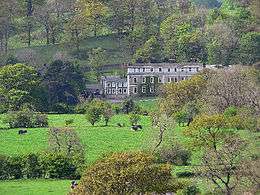Waddow Hall
Waddow Hall is a 17th-century Grade II listed building within a 178-acre (72 ha) estate that serves as a conference and activity centre for Girlguiding UK near Clitheroe, Lancashire.[1][2] Waddow Hall has been managed by Girlguiding since 1927.[1]
| Waddow Hall | |||
|---|---|---|---|
 Waddow Hall | |||
| Owner | Girlguiding UK | ||
| Location | Waddington, Lancashire | ||
| Country | England | ||
| Coordinates | 53.8797°N 2.4047°W | ||
|
| |||
| Website http://www.waddow.org.uk | |||
Listed Building – Grade II | |||
| Designated | 16 November 1954 | ||
| Reference no. | 1318094 | ||
History
The Waddow estate and the Parish of Waddington were managed by Roger de Tempest of Bracewell, Lord of Waddington in 1267. Waddow Hall was built by the Tempest family during the Tudor period,[3] and the estate and lands remained in the Tempest family until 1657, when Richard Tempest died in a debtors' prison.[4]

Following Richard Tempest's death in prison, the land and buildings of the Waddow estate were acquired in 1658 by Christopher Wilkinson of Clitheroe, an out-bailiff and later a Member of Parliament. Wilkinson bequeathed the estate and buildings to his nephew John Weddell of Widdington in 1693 (rather than to his own son whom he suspected of popery) and the property remained in the Weddell family until 1778, when Thomas Weddell bequeathed them to Sir John Ramsden.[4]
Waddow remained in the Ramsden family until the mid-1800s, when it was sold to William Garnett by Sir John Ramsden, 5th Baronet. The Girl Guides Association rented the Estate between 1927 and 1928, using it as an activity centre, and purchased it for £9,000 from William Garnett's son on 16 October 1928.[4]
During the Second World War the estate was lent to Lancashire County Council, and served as an isolation hospital for children.[4][5]
Haunting
According to local folklore the estate is haunted by the ghost of O'Nell, a former servant at the hall, who was either murdered by her mistress, or died in an accidental fall. The legend suggests that O'Nell was sent to fetch water from a well, when her mistress cast a spell on her, causing her to slip and die, or had expressed the wish that she fall.[6][7]
In November 2004 the British paranormal reality television show Most Haunted broadcast an episode from Waddow Hall.[8]
References
- "Waddow Hall". Waddow Hall, Waddington. British Listed Buildings. Retrieved 12 December 2011.
- "Training and Activity Centres". Waddow Hall. Girlguiding UK. Retrieved 12 December 2011.
- "Forest of Bowland". Towns and Villages. Forest of Bowland. Retrieved 15 December 2011.
- Waddow Hall. Vine Press | The Girl Guides Association. 1981.
- "Rescued Heritage Open Days unveil festival of unseen sites". Culture24. 5 August 2009. Retrieved 12 December 2011.
- Hole, Christina (2004). Haunted England: A Survey of English Ghost Lore 1941. Kessinger Publishing. pp. 2–3.
- Spence, Lewis (1948). The minor traditions of British mythology. Ayer Publishing. pp. 12–13.
- "Most Haunted Live Episode 11". Pendle Hill. The Paranormal Experience. Retrieved 19 December 2011.